Research Article
LC-MS and GC-MS Spectrometry Based Isotopic Abundance Ratio Analysis of the Consciousness Energy Healing Treated Pyridoxine Using LC-MS and GC-MS Spectrometry
14223
Views & Citations13223
Likes & Shares
Pyridoxine (vitamin B6) is commonly found in foods and dietary supplements, has an important role in physiologic development. In this study, the influence of the Trivedi Effect®-Biofield Energy Healing Treatment on the structural properties and the isotopic abundance ratio of vitamin B6 were evaluated using LC-MS and GC-MS. Vitamin B6 sample was divided into two parts and termed as control and treated samples. Only the treated vitamin B6 was received the Trivedi Effect®-Consciousness Energy Healing Treatment remotely by a well-known Biofield Energy Healer, Dahryn Trivedi. The LC-MS spectra of both the vitamin B6 samples at retention time 2.3 min exhibited the mass of the protonated molecular ion peak [M+H]+ at m/z 170 (calculated for C8H12NO3+, 170.08) in the MS spectrum. The peak area% of the treated vitamin B6 was increased by 1.32% compared to the control sample. The isotopic abundance ratio of PM+1/PM in the treated vitamin B6 was significantly decreased by 36.94% compared with the control sample. Thus, 13C, 2H, 15N, and 17O contributions from (C8H12NO3)+ to m/z 171 in the treated sample were significantly decreased compared with the control sample. Similarly, in the GC-MS chromatograms, the peak area of the treated sample was increased by 4.54% compared to the control sample. Similarly, the mass peak intensity of the treated vitamin B6 at m/z 153 was significantly increased by 66.69% compared to the control sample. The isotopic abundance ratio of PM+1/PM (2H/1H or 13C/12C or 15N/14N or 17O/16O) and peak area in the treated vitamin B6 was significantly decreased compared to the control sample. The decreased isotopic abundance ratio of the treated vitamin B6 may decrease the intra-atomic bond strength, decrease its physical stability. The increased peak area of the treated vitamin B6 might be responsible for the increase in solubility and bioavailability compared to the control sample. The new form of vitamin B6 would be better for designing more efficacious pharmaceutical formulations for the prevention and treatment of vitamin B6 deficiency, anaemia, seizures, cardiovascular disease, tuberculosis, Alzheimer’s disease, cancer, anxiety, hypertension, asthma, depression, dysmenorrhea, breast pain, etc.
Keywords: The Trivedi Effect®, Biofield Energy, Consciousness Energy Healing Treatment, Vitamin B6, Isotopic abundance
INTRODUCTION
Pyridoxine (vitamin B6) is a water-soluble vitamin and has an important role in physiologic development [1]. Vitamin B6 is naturally found as pyridoxal, pyridoxine, and pyridoxamine; in the human body, all the forms converted into pyridoxal phosphate (the active form of vitamin B6) [2]. Vitamin B6 commonly found in foods (fish, poultry, meat, tofu, chickpeas, nuts, bananas, whole grains, spinach, etc.) and dietary supplements [2,3]. Pyridoxal phosphate acts as a coenzyme for more than 100 enzymatic reactions; biosynthesis of neurotransmitters; maintaining healthy levels of homocysteine, the amino acid in the blood; gluconeogenesis, glycogenolysis, immune function, hemoglobin formation; involved in the metabolism of amino acid, carbohydrates, and lipids [2-5]. Pyridoxine hydrochloride is a salt form of vitamin B6 commonly used in the pharmaceutical industries [6].
Vitamin B6 generally used for the prevention and treatment of vitamin B6 deficiency diseases, metabolic disorder, Alzheimer’s disease, sideroblastic anemia, anxiety, asthma, cardiovascular disease, pulmonary tuberculosis, diabetes, hyperhomocysteinaemia, cancer, pyridoxine-dependent epilepsy, depression, attention deficit hyperactivity disorder, dysmenorrhea, post-partum lactation suppression, McArdle’s disease, osteoporosis, nausea and vomiting in pregnancy, problems from isoniazid, mushroom poisoning, etc. [1,3-8]. Vitamin B6 rarely shows side effects, but it can interact with the drugs like valproic acid, carbamazepine, phenytoin, cycloserine, and theophylline, which might adversely affect vitamin B6 levels in the body [3,5]. Vitamin B6 is very sensitive to light. It is soluble in water and alcohol, sparingly soluble acetone and insoluble in ether and chloroform. When it heated to decomposition, it emits very toxic oxide fumes of nitrogen and hydrogen chloride [9].
The physical and chemical properties of any drug material play a vital role in the solubility, absorption, bioavailability, etc. Improvement of the quality of drug with respect to the solubility, stability, and bioavailability is the biggest challenge for the pharmaceutical scientists. The Trivedi Effect®-Consciousness Energy Healing Treatment in larger extent has the incredible impact on the particle size, surface area, crystal size, thermal properties, and bioavailability of pharmaceutical/nutraceutical compounds [10-14]. Whereas, the Trivedi Effect® is a natural and only scientifically proven phenomenon in which an individual can control and make use of this inherently intelligent energy anywhere on the planet via the possible mediation of neutrinos [15].
In the human body the continuous moment of the ions, cells, blood, heart, etc. form a quantum of energy matrix around the body is called the “Biofield Energy” [16,17]. Biofield Energy Healers can pass this energy into any living or nonliving object(s) anywhere on the planet, and the overall process is called Biofield Energy Healing Treatment [17,18]. This treatment has significant positive outcomes against various disease [19]. The National Center of Complementary and Integrative Health has recognized and accepted Biofield Energy Healing as a Complementary and Alternative Medicine (CAM) health care approach along with the other therapies, medicines, and practices, such as yoga, Ayurveda, Qi Gong, Tai Chi, etc. [20,21]. Most of the USA population has accepted these CAM therapies [22]. Similarly, the Trivedi Effect® also have reported astonishing scientific results altering the physicochemical and thermal properties of the several non-living and living object(s), i.e., organic compounds, metals, polymers, ceramic, crops, microbes, cancer cells [23-30], etc. The Trivedi Effect®-Consciousness Energy Healing Treatment has also enhanced the isotopic abundance ratio of organic compounds [31,32].
In order to understand the isotope effects resulting from the variation of the isotopic composition of the molecule, the stable isotope ratio analysis is important and it has many applications in different field of science [33,34]. The isotope ratio analysis usually performed by using the gas chromatography-mass spectrometry (GC-MS) and liquid chromatography-mass spectrometry (LC-MS) in low micromolar concentration with sufficient precision [34,35]. Therefore, the structural properties characterization and the isotopic abundance ratio analysis of PM+1/PM (2H/1H or 13C/12C or 15N/14N or 17O/16O) in the Trivedi Effect®-Consciousness Energy Healing Treated vitamin B6 was performed compared to the control sample using LC-MS and GC-MS analytical techniques.
MATERIALS AND METHODS
- Chemicals and Reagents
The test sample pyridoxine hydrochloride (100%) was purchased from TCI, Japan and remaining chemicals used in the experiments were purchased in India.
- Consciousness Energy Healing Treatment Strategies
The test sample pyridoxine hydrochloride powder sample was divided into two parts. One part of the sample was called the control sample, which did not receive the Trivedi Effect®-Consciousness Energy Healing Treatment, but was treated with a “sham” healer who did not have any knowledge about the Biofield Energy Treatment. However, the other part called the Biofield Energy Treated pyridoxine received the Consciousness Energy Healing Treatment remotely under standard laboratory conditions for 3 min through the healer’s unique energy transmission process by the renowned Biofield Energy Healer, Dahryn Trivedi, USA. After the treatment both the vitamin B6 samples were kept in sealed conditions and characterized using sophisticated analytical techniques.
- Characterization
- Liquid Chromatography-Mass Spectrometry (LC-MS) Analysis and Calculation of Isotopic Abundance Ratio
The LC-MS analysis of vitamin B6 was carried out with the help of LC-MS ThermoFisher Scientific (USA) equipped with an ion trap detector connected with a triple-stage quadrupole mass spectrometer. The reversed phase column Thermo Scientific Synchronis C18 (Length-250 mm X ID 4.6 mm X 5 micron), maintained at 25˚C was used. Methanol and water were used as diluent for the sample preparation. 10 µL of vitamin B6 solution was injected, and the analyte was eluted using acetonitrile + 5 mM ammonium acetate (80:20) pumped at a constant flow rate of 1 mL/min. Chromatographic separation was achieved using gradient condition and the total run time was 10 min. Peaks were monitored at 220 nm using the PDA detector. The mass spectrometric analysis was performed under +ve ESI mode.
The values of the natural isotopic abundance of the common elements are obtained from the literature [34,36-38]. The LC-MS based isotopic abundance ratio (PM+1/PM) for both the samples was calculated using equation 1.

Where IARControl and IARTreated is the isotopic abundance ratio in the treated and control vitamin B6 sample, respectively.
- Gas chromatography-mass spectrometry (GC-MS) analysis
GC-MS of the vitamin B6 samples were analyzed with the help of Perkin Elmer Gas chromatograph equipped with a PE-5MS (30M x 250 micros x 0.250 microns) capillary column and coupled to a single quadrupole mass detector was operated with electron impact (EI) ionization in positive mode. The oven temperature was programmed from 75°C (5 min hold) to 250°C (2.5 min hold) @ 10°C /min (total run time 25 min). The sample was prepared taking 100 mg of the vitamin B6 in 4 ml methanol as a diluent. Injection volume was 5 µl. The % change in the peak area and mass peak intensities of the treated vitamin B6 was calculated compared to the control sample using the following equation 2:


RESULTS AND DISCUSSION
- Liquid chromatography-mass spectrometry (LC-MS)
The hydrochloride salt of vitamin B6 samples showed a single major chromatographic peak at retention time (Rt) of 2.3 min (Figure 1). The peak area% of the Biofield Energy Treated vitamin B6 was increased by 1.32% compared to the control sample. The mass spectra of both the samples exhibited the protonated molecular mass peak [M+H] + at m/z 170 (calculated for C8H12NO3+, 170.08) with 100% base peak intensity in the MS spectrum in +ve ion mode was confirmed to be vitamin B6 (Figures 2 and 3), which was reported in the literature [39]. Further, other lower-mass peaks at m/z 152, 134, 125, and 94 for C8H10NO2+, C8H8NO•+, C7H11NO2+, and C6H8N+, respectively in both the samples (Figures 2 and 3).
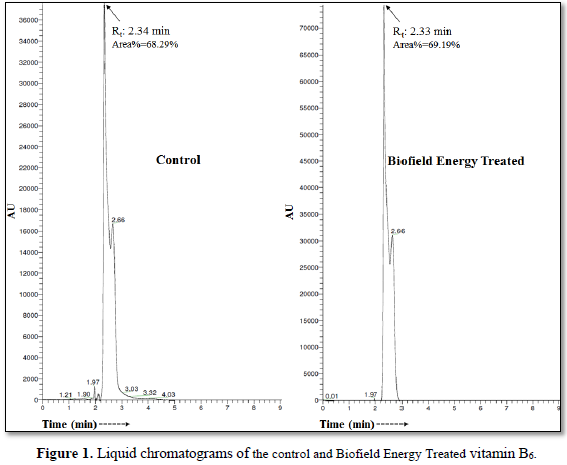

The LC-MS based theoretical calculation of PM+1 for vitamin B6 was presented as below:
P (13C) = [(8 x 1.1%) x 100% (the actual size of the M+ peak)] / 100% = 8.8%
P (2H) = [(12 x 0.015%) x 100%] / 100% = 0.18%
P (15N) = [(1 x 0.40%) x 100%] / 100% = 0.4%
P (17O) = [(3 x 0.04%) x 100%] / 100% = 0.12%
PM+1 i.e.,13C, 2H, 15N, and 17O contributions from C8H12NO3+ to m/z 171 = 9.5%
From the above calculation, it has been found that 13C and 15N have major contribution to m/z 171.
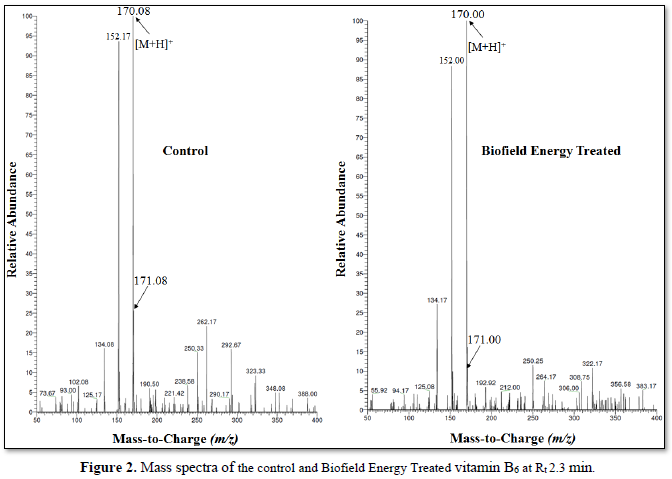
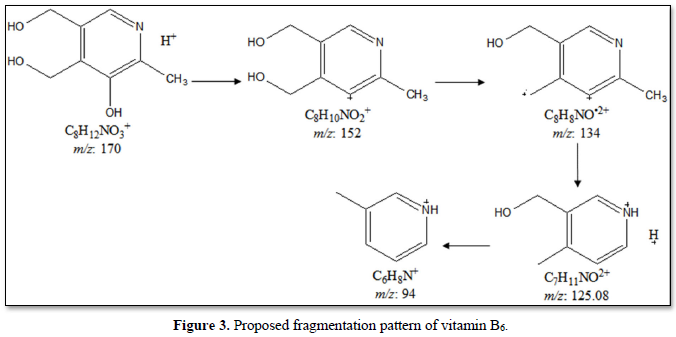


The LC-MS based isotopic abundance ratio analysis PM and PM+1 for vitamin B6 near m/z 170 [M+] and 171[(M+1) +], respectively of both the samples (Table 1). The isotopic abundance ratio PM+1/PM in the Biofield Energy Treated vitamin B6 was significantly decreased by 36.94% compared with the control sample (Table 1). Therefore, it was concluded that the 13C, 2H, 15N, 17O contributions from (C8H12NO3) + to m/z 171 in the Biofield Energy Treated vitamin B6 was significantly increased compared to the control sample.


- Gas chromatography-mass spectrometry (GC-MS) analysis
The GC-MS chromatograms of both the vitamin B6 samples are shown in Figures 4 and 5. The chromatographic peak was obtained at Rt 16.9 min in both the sample, but peak area of the Biofield Energy Treated sample (36903272) was increased by 4.54% (Table 2) compared to the control sample (35301072). This indicated that the solubility of the Biofield Energy Treated vitamin B6 was increased. The data was supported by one of the recently published articles, in which the data showed that the particle sizes of the vitamin B6 were significantly decreased and the surface area was significantly increased after the Biofield Energy Treatment [40].
The corresponding mass spectra for the chromatographic peak at Rt of ~17 min of both the samples of vitamin B6 exhibited the presence of the dehydrated molecular ion peak at m/z 151 (calcd for C8H9NO2•+, 151.06) (Figures 4 and 5). The other mass fragmentation peak at lower m/z 124 (C7H10NO2+), 106 (C7H8N+), 94 (C6H8N+) were also observed in both vitamin B6 mass spectra (Figures 4 and 5). But the mass peak intensities of the treated sample were significantly altered compared to the control vitamin B6. The mass peak intensity of the Biofield Energy Treated vitamin B6 at m/z 153 was significantly increased by 66.69% compared to the control sample (Table 2).
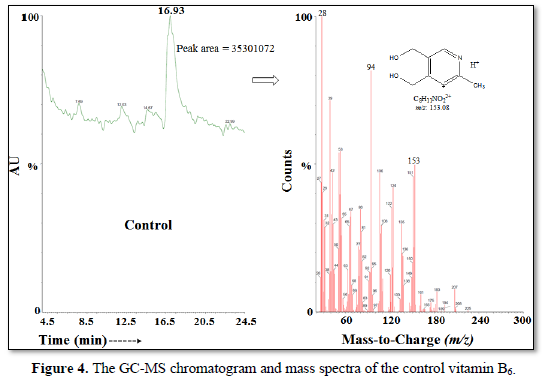
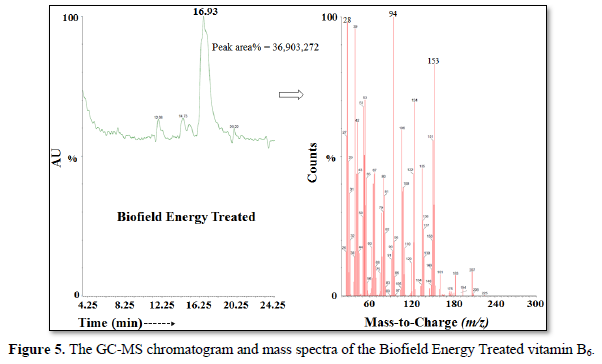




LC-MS and GC-MS structural analysis confirmed the sample as vitamin B6. The isotopic abundance ratio of PM+1/PM (2H/1H or 13C/12C or 15N/14N or 17O/16O) in the Biofield Energy Treated vitamin B6 was significantly decreased compared to the control sample. Similarly, the peak area and mass peak intensity of the vitamin B6 sample was improved after the Biofield Energy Treatment. All these characteristic changes in vitamin B6 could be due to changes in nuclei possibly through the interference of neutrino particles via the Trivedi Effect®-Consciousness Energy Healing Treatment [15]. Neutrino is a subatomic particle with no charge and small mass, which is one of the most abundant particles in the universe. These neutrinos have the ability to interact with protons and neutrons in the nucleus and the formation of isotopes [15,34,35]. The decreased isotopic abundance ratios 2H/1H or 13C/12C or 17O/16O or 18O/16O would influence the atomic bond vibration of treated vitamin B6 [41]. The decreased isotopic abundance ratio of the treated vitamin B6 may decrease the intra-atomic bond strength, decrease its physical stability. The Trivedi Effect®-Consciousness Energy Healing Treated vitamin B6 would be more soluble and bioavailable compared to the control sample. It would be helpful to design more efficacious nutraceutical and pharmaceutical formulations for the prevention and treatment of vitamin B6 deficiency disorders, sideroblastic anemia, premenstrual syndrome, seizures, cardiovascular disease, tuberculosis, metabolic disorders, Alzheimer’s disease, cancer, hyperhomocysteinemia, anxiety, hypertension, asthma, depression, dysmenorrhea, akathisia, angioplasty, birth outcomes, cognitive function, hyperkinetic cerebral dysfunction syndrome, carpal tunnel syndrome, breast pain, lactation suppression, McArdle’s disease, autism, osteoporosis, Tardive dyskinesia, etc.
CONCLUSIONS
The Trivedi Effect®-Consciousness Energy Healing Treatment showed a significant impact on the isotopic abundance ratio, peak area, and mass peak intensities of vitamin B6. The LC-MS spectra of both the control and Biofield Energy Treated vitamin B6 samples have same retention time, 2.3 min exhibited the mass of the protonated molecular ion peak [M+H] + at m/z 170 in the MS spectrum. The peak area% of the Biofield Energy Treated vitamin B6 was increased by 1.32% compared to the control sample. The isotopic abundance ratio of PM+1/PM in the Biofield Energy Treated vitamin B6 was significantly decreased by 36.94% compared with the control sample. Thus, 13C, 2H, 15N, and 17O contributions from (C8H12NO3) + to m/z 171 in the Biofield Energy Treated sample were significantly decreased compared with the control sample. Similarly, in the GC-MS chromatograms, the peak area of the Biofield Energy Treated sample was increased by 4.54% compared to the control sample. The mass peak intensity of the treated vitamin B6 at m/z 153 was significantly increased by 66.69% compared to the control sample. The isotopic abundance ratio of PM+1/PM (2H/1H or 13C/12C or 15N/14N or 17O/16O) and peak area in the treated vitamin B6 was significantly decreased compared to the control sample. It changes in isotopic abundance, peak area, and mass peak intensities could be due to changes in nuclei possibly via the interference of neutrino particles controlled by the Trivedi Effect®. The decreased isotopic abundance ratio of the treated vitamin B6 may decrease the intra-atomic bond strength, decrease its physical stability. The increased peak area of the treated vitamin B6 might be responsible for the increase in solubility and bioavailability compared to the control sample. The new form of vitamin B6 would be better for designing more efficacious pharmaceutical formulations for the prevention and treatment of vitamin B6 deficiency, hereditary sideroblastic anemia, premenstrual syndrome, pyridoxine-dependency seizures, febrile seizures, cardiovascular disease, pulmonary tuberculosis, metabolic disorders, Alzheimer’s disease, cancer, hyperhomocysteinemia, anxiety, hypertension, asthma, depression, attention deficit hyperactivity disorder, dysmenorrhea, akathisia, angioplasty, cognitive function, hyperkinetic cerebral dysfunction syndrome, carpal tunnel syndrome, breast pain, pregnancy-induced nausea and vomiting in pregnancy, lactation suppression, McArdle’s disease, autism, osteoporosis, Tardive dyskinesia, stroke recurrence, etc.
ACKNOWLEDGMENTS
The authors are grateful to Sophisticated Instrumentation Centre for Applied Research & Testing (SICART) India, Trivedi Science, Trivedi Global, Inc., Trivedi Testimonials, and Trivedi Master Wellness for their assistance and support during this work.
- World Health Organization (2009) WHO Model Formulary 2008. pp: 496. Available online at: https://www.who.int/selection_medicines/list/WMF2008.pdf
- Falsaperla R, Saporito MAN, Stefano VD, Mauceri L, Quattrocchi E, et al. (2017) Pyridoxine supplementation during pregnancy, lactation and the first months of life: A review of the literature. Curr Pediatr Res 21: 613-619.
- S. Department of Agriculture, Agricultural Research Service (2011) USDA National Nutrient Database for Standard Reference, Release 24.
- Dakshinamurti S, Dakshinamurti K (2007) Vitamin B6 in Handbook of Vitamins, 4th Zempleni J, Rucker RB, McCormick DB, Suttie JW, CRC Press, Taylor & Francis Group, Boca Raton, USA. pp: 315-360.
- Nayak G, Trivedi MK, Branton A, Trivedi D, Jana S (2019) Consciousness energy healing treatment: impact on the physicochemical and thermal properties of pyridoxine HCl. Int J Nut 4: 26-37.
- Aboul-Enein HY, Loutfy MA (1984) Pyridoxine Hydrochloride in Analytical Profiles of Drug Substances, Florey K (Ed.), Academic Press, Inc., Orlando, USA. Vol 13, pp: 448-478.
- AlSaad D, Awaisu A, Elsalem S, Abdulrouf PV, Thomas B, et al. (2019) Is pyridoxine effective and safe for post-partum lactation inhibition? A systematic review. J Clin Pharm Ther42(4): 373-382.
- Pyridoxine Hydrochloride (2019) The American Society of Health-System Pharmacists. Accessed on: June 27, 2019.
- Pyridoxine Hydrochloride - Stability. Accessed on: June 27, 2019. Available online at: https://pubchem.ncbi.nlm.nih.gov/compound/pyridoxine_hydrochloride#section=Stability
- Trivedi D, Trivedi MK, Branton A, Nayak G, Jana S (2019) Consciousness energy healing treatment: Impact on the physicochemical and thermal properties of ascorbic acid. Food Nutr Current Res 2: 164-173.
- Nayak G, Trivedi MK, Branton A, Trivedi D, Jana S (2018) Evaluation of the consciousness energy healing treated berberine chloride using PXRD, PSA, and DSC Analysis. Food Sci Nutr Technol 3: 000168.
- Branton A, Jana S (2017) Effect of the biofield energy healing treatment on the pharmacokinetics of 25-hydroxyvitamin D3 [25(OH)D3] in rats after a single oral dose of vitamin D3. Am J Pharmacol Phytother 2: 11-18.
- Nayak G, Trivedi MK, Branton A, Trivedi D, Jana S (2018) Consciousness energy healing treatment: Impact on physicochemical and thermal properties of silver sulfadiazine. J Adv Pharm Sci Technol 2: 1-13.
- Branton A, Trivedi MK, Trivedi D, Nayak G, Jana S (2018) Evaluation of the physicochemical and thermal properties of the biofield energy healing treated ofloxacin. J Pharm Pharmaceutics 5: 80-87.
- Trivedi MK, Mohan TRR (2016) Biofield energy signals, energy transmission and neutrinos. Am J Mod Phys 5: 172-176.
- Rubik B, Muehsam D, Hammerschlag R, Jain S (2015) Biofield science and healing: History, terminology, and concepts. Glob Adv Health Med 4: 8-14.
- Nemeth L (2008) Energy and biofield therapies in practice. Beginnings 28: 4-5.
- Rubik B (2002) The biofield hypothesis: Its biophysical basis and role in medicine. J Altern Complement Med 8: 703-717.
- Warber SL, Cornelio D, Straughn, J, Kile G (2004) Biofield energy healing from the inside. J Altern Complement Med 10: 1107-1113.
- Koithan M (2009) Introducing complementary and alternative therapies. J Nurse Pract 5: 18-20.
- Movaffaghi Z, Farsi M (2009) Biofield therapies: Biophysical basis and biological regulations? Complement Ther Clin Pr 15: 35-37.
- Barnes PM, Bloom B, Nahin RL (2008) Complementary and alternative medicine use among adults and children: United States, 2007. Natl Health Stat Report 12: 1-23.
- Trivedi MK, Branton A, Trivedi D, Nayak G, Sethi KK, et al. (2016) Isotopic abundance ratio analysis of biofield energy treated indole using gas chromatography-mass spectrometry. Sci J Chem 4: 41-48.
- Dabhade VV, Tallapragada RMR, Trivedi MK (2009) Effect of external energy on the atomic, crystalline, and powder characteristics of antimony and bismuth powders. Bull Mater Sci 32: 471-479.
- Nayak G, Trivedi MK, Branton A, Trivedi D, Jana S (2018) Physicochemical and thermal properties of consciousness energy healing treated hydroxypropyl β-cyclodextrin. Med Analy Chem Int J 2: 000124.
- Nayak G, Trivedi MK, Branton A, Trivedi D, Jana S (2018) The physicochemical and thermal properties of consciousness energy healing treated silver oxide (Ag2O). Aspects Min Miner Sci. 2: 1-6.
- Sances F, Flora E, Patil S, Spence A, Shinde V (2013) Impact of biofield treatment on ginseng and organic blueberry yield. AGRIVITA. J Agric Sci 35: 22-29.
- Trivedi MK, Branton A, Trivedi D, Nayak G, Gangwar M, et al. (2015) Morphological and molecular analysis using RAPD in biofield treated sponge and bitter gourd. Am J Agric Forest 3: 264-270.
- Trivedi MK, Branton A, Trivedi D, Shettigar H, Nayak G, et al. (2015) Assessment of antibiogram of multidrug-resistant isolates of Enterobacter aerogenes after biofield energy treatment. J Pharma Care Health Sys 2: 145.
- Trivedi MK, Patil S, Shettigar H, Mondal SC, Jana S (2015) The potential impact of biofield treatment on human brain tumor cells: A time-lapse video microscopy. J Integr Oncol 4: 141.
- Trivedi MK, Branton A, Trivedi D, Nayak G, Sethi KK, et al. (2016) Determination of isotopic abundance ratio of biofield energy treated 1,4-dichlorobenzene using gas chromatography-mass spectrometry (GC-MS). Mod Chem 4: 30-37.
- Trivedi MK, Branton A, Trivedi D, Nayak G, Panda P, et al. (2016) Gas chromatography-mass spectrometric analysis of isotopic abundance of 13C, 2H, and 18O in biofield energy treated p-tertiary butylphenol (PTBP). Am J Chem Eng 4: 78-86.
- Schellekens RC, Stellaard F, Woerdenbag HJ, Frijlink HW, Kosterink JG (2011) Applications of stable isotopes in clinical pharmacology. Br J Clin Pharmacol 72: 879-897.
- Weisel CP, Park S, Pyo H, Mohan K, Witz G (2003) Use of stable isotopically labeled benzene to evaluate environmental exposures. J Expo Anal Environ Epidemiol 13: 393-402.
- Muccio Z, Jackson GP (2009) Isotope ratio mass spectrometry. Analyst 134: 213-222.
- Rosman KJR, Taylor PDP (1998) Isotopic compositions of the elements 1997 (Technical Report). Pure Appl Chem 70: 217-235.
- Smith RM (2004) Understanding Mass Spectra: A Basic Approach, Second Edition, John Wiley & Sons, Inc.
- Jürgen H (2004) Gross Mass Spectrometry: A Textbook (2nd Edn) Springer: Berlin.
- Aranda M, Morlock G (2006) Simultaneous determination of riboflavin, pyridoxine, nicotinamide, caffeine and taurine in energy drinks by planar chromatography-multiple detection with confirmation by electrospray ionization mass spectrometry. J Chromatogr A 1131: 253-260.
- Trivedi D, Trivedi MK, Branton A, Nayak G, Jana S (2018) Evaluation of consciousness energy healing treated pyridoxine (vitamin B6). Global J Med Res: (L) Nut Food Sci XVIII: 15-23.
- Santesteban LG, Miranda C, Barbarin I, Royo JB (2014) Application of the measurement of the natural abundance of stable isotopes in viticulture: A review. Aust J Grape Wine Res 21: 157-167.
QUICK LINKS
- SUBMIT MANUSCRIPT
- RECOMMEND THE JOURNAL
-
SUBSCRIBE FOR ALERTS
RELATED JOURNALS
- Journal of Genetics and Cell Biology (ISSN:2639-3360)
- Proteomics and Bioinformatics (ISSN:2641-7561)
- Food and Nutrition-Current Research (ISSN:2638-1095)
- Journal of Astronomy and Space Research
- Journal of Veterinary and Marine Sciences (ISSN: 2689-7830)
- Journal of Genomic Medicine and Pharmacogenomics (ISSN:2474-4670)
- Journal of Biochemistry and Molecular Medicine (ISSN:2641-6948)






